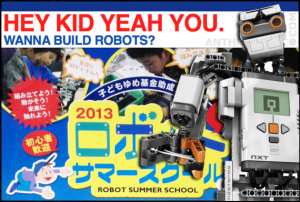They once had little to do with actual robotics, but two product iterations and 15 years later, about to release their 3rd-generation kit [sic], Lego is at the top of educational, DIY, and plain old fun robot building. MINDSTORMS EV3 is coming, and the robo-geekosphere is buzzing…and whirring.
• • •
[SHARED WITH PERMISSION; ORIGINALY PUBLISHED AT AKIHABARANEWS.COM]
Legos, Robots, and Education
The basic underlying concept of the Lego – build it yourself – actually fits quite well with most practical robotics development. See, unless your project has been underway for several years, has reached Kickstarter-ready status, or is swimming in government, major university, or massive global corporation cash (e.g., commercial drones, industrial robotics, ASIMO, Robonaut, ATLAS, HRP, HUBO, etc.), robotics research is an almost intrinsically small-group, bootstrapped DIY endeavor. Early-stage work begins with a design (or freestyle!), then the collection and assembly of workable off-the-shelf parts or building/machining them by hand, then doing something about a power source, software, etc., etc., carefully incorporating all variables, and then maybe: voilà – robot! Maybe even some YouTube fame.
Something like that, anyway. Oh, but here’s the thing: chances are you won’t see such opportunities early-on in life. Broadly speaking, the status quo of hands-on robotics education and experimentation is somewhat exclusive to the ranks of higher education. Historically (if that term even works in robotics), budding engineers – who might not even know that’s what they are or can be – just haven’t had easy access to affordable, practical robotics development education.
Communities based around a single, seemingly humble line of products, Lego MINDSTORMS, are stepping in to fill this gap; whether or not Lego set out to become this force of change is irrelevant – they have. Sure, there are plenty of non-Lego, non-giant-global toy corporation build-your-own-robot kits on the market, but none of them can match Lego MINDSTORMS’ combination of price (approximately U.S. $350 for the upcoming EV3), brand familiarity, open-source & intuitive programmability, sophistication, and a supportive, collaborative global network of developers and makers.

It’s fair to say that if the so-called Robotics Revolution/Resurgence/Renaissance is actually underway, then the Lego Group is supplying a considerable portion of humanity’s basic training.
MINDSTORMS in Practice:
Kumamoto City, Japan’s ‘The NPO Hito Project’
Even here in high-test-scores Japan, extra-curricular robotics and STEM education in general (Science, Technology, Engineering, Mathematics) is needed, and in many cases, it’s being taught with Lego MINDSTORMS kits. The NPO Hito Project’s 2013 Robot Summer School, covered last month here at AkihabaraNews, assigns a single kit to groups of 2-3 elementary or junior high school students and begins with programming. Then, over the course of two 4-hour instruction sessions held on consecutive Saturdays, kids get intensive, hands-on experience in robotics engineering, building, and very importantly, having fun with technology they themselves can design and control. Oh, and luckily for all involved, and assuredly not very common on this point, classes for the nearly 80 students enrolled in this year’s Robot Summer School were free of charge.
(NPO Hito Project Facebook page – Japanese/日本語, but with photos)
Portland, Oregon, U.S.A.’s ‘Little Engineers’
This group’s wide range of robotics education courses use Lego MINDSTORMS kits almost exclusively. Like their Japanese counterpart, Little Engineers is dedicated to robotics education as it should be: based firmly in a comprehensive STEM context. Students from preschool to high school are accepted, and they can spend up to an entire 7-hour day at work on their projects. Robotics classes range from “Early Simple Machines” for 3-5 year-olds to “LEGO Robotics, Design, Build and Program” for students 8 or older. At the higher levels, instruction includes curricula from universities and the Lego Education program. Rightfully so, Little Engineers’ robotics classes are not free, but considering the hours, the wide variety of classes, and that students can return and advance their studies in a familiar contenxt, they’re still a bargain for long-form, hands-on robotics and STEM instruction.
(Little Engineers homepage)
In Japan, in the U.S., and around the developed world, where so many of the artifacts of everyday life have become push-button or touch-screen, there is justifiable concern over the erosion of practical, tactile problem solving and building skills – essential precursors to engineering proper. Thankfully, to address this actual and figurative disconnect, at least one very effective model is more than evident, and it is applicable across cultures.
If Lego’s MINDSTORMS kits provide a framework for basic training, it seems then that, until educational institutions catch up at the primary and secondary levels, the NPO Hito Project, Little Engineers, and other like organizations – they will be the oh-so-needed drill instructors in the aforementioned Robotics Revolution/Resurgence/Renaissance.
Lego MINDSTORMS EV3:
Available September 1, 2013
Hobbyists, students, research professionals, and tech-geeks of all shades have worked with variations of the MINDSTORMS NXT for the past 7 years (and, reportedly, many of the pre-NXT bricks still function very well), but the new hottness is about to arrive. Announced at CES 2013 and already in the hands of developers and certain educational groups (Little Engineers actually received their Education Kit just yesterday), the long-anticipated EV3 update will roll out to the general public in just about three weeks. A new online hub for developer communities is also in the works and is expected to launch simultaneously.
As always with MINDSTORMS, EV3 is a complete kit that includes motors, various sensors, the programmable MINDSTORMS “brick” (the brains of the affair), multi-platform programming software, 550+ LEGO Technic elements, a remote control, and brand-new this time: smartphone-based control and programming and an iPad-based 3D design app. The brick is Bluetooth enabled, has a USB port, an SD expansion slot, and runs on an open-source Linux platform, i.e., it’s completely open to being hacked, chopped, and rejiggered in any way the imagination would allow. For the creative and curious, the the possibilities are awesome. One might even make a Lego MINDSTORMS…ummm, Beer Machine:
Along with the kit’s 5 included robot models/templates, Lego is providing 12 downloadable models (pictured below in high-res) designed by an international group of developers. We’re looking forward to seeing imaginations unleashed in YouTube demos and tutorials, and of course there’s just as much to be said for the innovative tomfoolery sure to pour out within days of EV3’s launch.
Well Done, Lego, Well Done – Now, Go Forth!
Admittedly, it does kinda have that ring to it, but this isn’t commercial for Lego – rather, let it be a statement of support for the concept of using robotics as a gateway to improving STEM education. And, let it be known among all members of the aforementioned robo-geekosphere, and anybody else paying attention, that it is hereby written and published forth upon the internets that Lego is already a hero of the early 21st century’s Robotics Revolution/Resurgence/Renaissance.
To wrap it up, if you’ve read this far, if you’ve watched the videos, and if somehow you remain unmoved and unmotivated to play/build/create, perhaps an alternative angle will spark a connection: think about your future boss or that of your children in an increasingly roboticized world – think, what are the odds that they played/built/created? Think hard, now!
Available MINDSTORMS EV3 Downloads (go here)












Big Shiny Color MINDSTORMS EV3 PDF Here
Images: Lego
[SHARED WITH PERMISSION; ORIGINALY PUBLISHED AT AKIHABARANEWS.COM]


![Lego Mindstorms EV3 Robotics Kit: World's Best Robotics Education Tool? [REISSUE] LEGO MINDSTORMS EV3 DOWNLOADS.anthrobotic.plate.REDUX](http://anthrobotic.com/wp-content/uploads/2014/12/LEGO-MINDSTORMS-EV3-DOWNLOADS.anthrobotic.plate_.REDUX_-e1417373941202.jpg)




